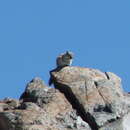fr
noms dans le fil d’Ariane


The call of T. alpinus is a thin, high pitched, repeated, sweet sound. When frightened, these animals will utter a startled whipper as it runs to shelter or safety.
Communication Channels: acoustic
Perception Channels: visual ; tactile ; acoustic ; chemical
Alpine chipmunks are not listed by CITES or IUCN.
US Federal List: no special status
CITES: no special status
IUCN Red List of Threatened Species: least concern
There are no known adverse affects of T. alpinus on humans.
No known benefits to humans.
As a prey species, these chipmunks probably have some effect on predator populations. Because of their seed caching behavior, these animals probably help to dispurse seeds of some plants.
Ecosystem Impact: disperses seeds
The diet of T. alpinus primarily consists of the small seeds of sedges and other alpine plants such as forbs, grasses, berries, and even some fungi. Some examples include bitter cherry (Prunus emarginata), currant (Ribes), blueberries and huckleberries (Vaccinium) and pussy-paws (Spraguea umbellate). Pussy-paws seem one of the most preferred foods of T. alpinus. They also eat the seeds of pines. There is some evidence that they will eat the eggs of the Rosy finch and White-crowned sparrow. They are able to conserve water by concentrating urine, and probably do not require a source of water other than the food they eat. They do store food in caches for use during the cold winter months when they awake from hibernation.
Animal Foods: eggs
Plant Foods: seeds, grains, and nuts; fruit
Other Foods: fungus
Foraging Behavior: stores or caches food
Primary Diet: herbivore (Granivore )
Alpine chipmunks (Tamias alpinus) are found exclusively in the Sierra Nevada Mountains of eastern and central California. They are found primarily at altitudes ranging from 2,300 to 3,900 m. Alpine chipmunks have the highest altitude range of any species in the genus Tamias.
Biogeographic Regions: nearctic (Native )
Tamias alpinus is found mostly in the talus slopes and sub-alpine forests at elevations from 2,300 m all the way up to the highest peaks of the Sierra Nevada Mountains. Talus slopes can be best described as slopes formed by an accumulation of rocky debris. Alpine chipmunks can also found among scattered boulders amongst lodgepole pines (Pinus contorta). The habitat of this species does include some pine forests, but studies have shown that T. alpinus does not spend a significant amount of time foraging there. As summer drags on, this high elevation climate tends to become quite arid, and maximum daily temperatures rarely exceed 20 degrees Celsius. In the rare instances when the temperature does climb above that mark, T. alpinus seeks the refuge of deep crevices of rocks and boulders, which seems to be important for thermoregulation. The air is generally still among the rocks and cliffs despite typically breezy conditions found at higher elevations.
Range elevation: 2,300 to 3,900 m.
Habitat Regions: temperate ; terrestrial
Terrestrial Biomes: forest ; mountains
Tamias alpinus typically lives about 2 to 3 years in the wild.
Typical lifespan
Status: wild: 2 to 3 years.
Tamias alpinus is a small chipmunk compared to others in the genus. It is generally a yellowish-gray color with lightly contrasting stripes that give it an overall pale coloration. The overall coloration helps the animals to hide among the gray rocks found in their habitat. The dark side stripes are either reddish or brownish, but are never black. However, the dark stripe that is found down the middle of the back may be black. The ventrum is typically bright orange, a coloration which continues down the underside of the tail. The upper portion of the tail is grayish-white to yellow.
The average length of an adult is 166 to 203 mm. Tail length is 63 to 85 mm. An average adult will typically weigh 28 to 50 grams. Some similar species include least chipmunks, which have a longer tail that is grayish to yellow. Also yellow-pine chipmunks, which are larger and more brightly colored. Finally, lodgepole chipmunks, which are larger and much more brown in color than the alpine chipmunk.
Range mass: 28 to 50 g.
Range length: 166 to 203 mm.
Other Physical Features: endothermic ; homoiothermic; bilateral symmetry
Sexual Dimorphism: sexes alike
Predation seems to be rather light because the rocky habitat provides quick escape routes and refuges. The lack of tree cover means that aerial predators such as raptors can be spotted at a considerable distance, increasing the chances of escaping the predator. The little predation that does occur is done so primarily by raptors, weasels, coyotes, foxes and bobcats.
Known Predators:
Anti-predator Adaptations: cryptic
No information was found on this subject.
Alpine chipmunks have only one litter per year that consists of 4 to 5 young. The young are born in early summer, typically in June and July. They typically build their nests deep in crevices between rocks. After about 30 to 45 days the young weigh about 20 grams, which is about 50% of the average body mass of an adult. After developing for about 90 days the young are the same size and weight as the adults.
Breeding interval: Alpine chipmunks breed once yearly.
Breeding season: Mating occurs in late winter and early spring.
Range number of offspring: 4 to 5.
Key Reproductive Features: iteroparous ; seasonal breeding ; gonochoric/gonochoristic/dioecious (sexes separate); sexual ; fertilization ; viviparous
Parental behavior of this species has not been reported. However, as is common for ground dwelling sciurids, females likely give birth to altricial young in subterranian nests where the young stay until they have developed sufficiently to move around above ground. Females provide young with milk. The role of males in parental care in this species is not known.
Parental Investment: no parental involvement; altricial ; pre-fertilization (Protecting: Female); pre-hatching/birth (Provisioning: Female, Protecting: Female); pre-weaning/fledging (Provisioning: Female, Protecting: Female); pre-independence (Provisioning: Female, Protecting: Female)